Small Business Saturday will be here before you know it, so we’ve put together a 5-step marketing guide that will help your small business brand knock it out of the park this year.
Related: 10 best social media campaigns you haven’t tried yet
1. Focus on a single goal
There’s a lot of hype around the biggest shopping weekend of the year. But that also means you have a lot of competition from retailers both online and off. To avoid burnout, it’s wise to pick one goal and stay laser-focused on it.
Of course, that doesn’t mean you can’t use multiple tactics to achieve this goal. Let’s say you own a beauty salon that relies heavily on referral business. Your goal may be to collect 200 referrals from existing customers. To make it happen, you’ll probably use a combination of email reminders, social media posts, and an in-store event. As long as every tactic points to your goal, you’re golden. Just be wary of offering competing promotions or asking for too much from your customers.
2. Take advantage of free design resources
American Express, the sponsor of Small Business Saturday, is offering several resources to participating small businesses. That includes downloadable templates for promotional material. These templates are good for showing your support of Small Business Saturday, but they don’t do a lot to promote your brand.
So we created a free template pack for you to customize with your branding for Small Business Saturday. All you need to do is sign up for Lucidpress (it’s free!), click the links below, then add your own logos and content.
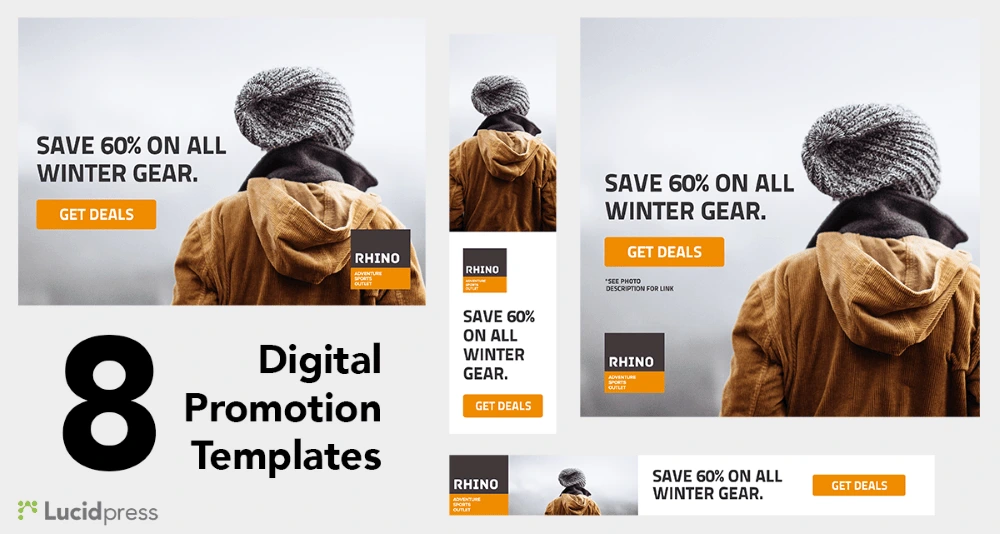
Free digital templates (click to access)
- Banner ad (160 x 600) template
- Banner ad (300 x 25) template
- Banner ad (728 x 90) template
- Webpage header template
- Facebook cover photo template
- Facebook photo post template
- Twitter photo post template
- Digital or print flyer template
3. Look far and wide for ideas
Every industry has its quirks. So instead of telling you which ideas are best for your business, we’ll show you how to find them yourself.
- Check with your local government and Chamber of Commerce. Often these organizations already have a plan for Small Business Saturday that you can easily piggyback on. For example, the state of Utah is running a “Shift Your Spending” campaign to encourage residents to allocate 10% of their holiday spending dollars to local businesses. Chambers of Commerce are also known to give out Small Business Saturday collateral, like postcards and storefront signs.
* Ask your peers for winning ideas. Do you belong to a trade organization? Connect with members to see what they’ve done in the past. Head to relevant subreddits and ask whether other business owners in your field have promotional ideas for the big day. Check out small business forums like Manta and see what fellow SMBs are planning. You can even request membership to a few groups on LinkedIn and join the conversation there.
* Sell for a season, not just a day. Recognize that your Small Business Saturday efforts should be part of a larger strategy for the holiday season. Sometimes googling “Small Business Saturday” yields the same ideas over and over. To get some fresh ideas, try searching for holiday-related keywords, e.g. [Industry name + holiday marketing ideas]. And be sure to check out the Small Business Administration’s list of holiday marketing ideas.
4. Ramp up your customer service
The biggest shopping weekend of the year is also your biggest opportunity to get new customers and lock in repeat business. Creminelli Fine Meats is a local producer of delicious artisanal meats in Utah, and no stranger to the importance of customer service.
Creminelli’s CMO Jeff Fuller says, “I have found that Black Friday, Small Business Saturday, and Cyber Monday are all fantastic opportunities to attract new customers. The combination of social media, outdoor media, and buzz-worthy deals drives a huge boost in sales. The key is to have amazing customer service during that long weekend, so you can earn a repeat visit from those same consumers—and hopefully another purchase at full price.”
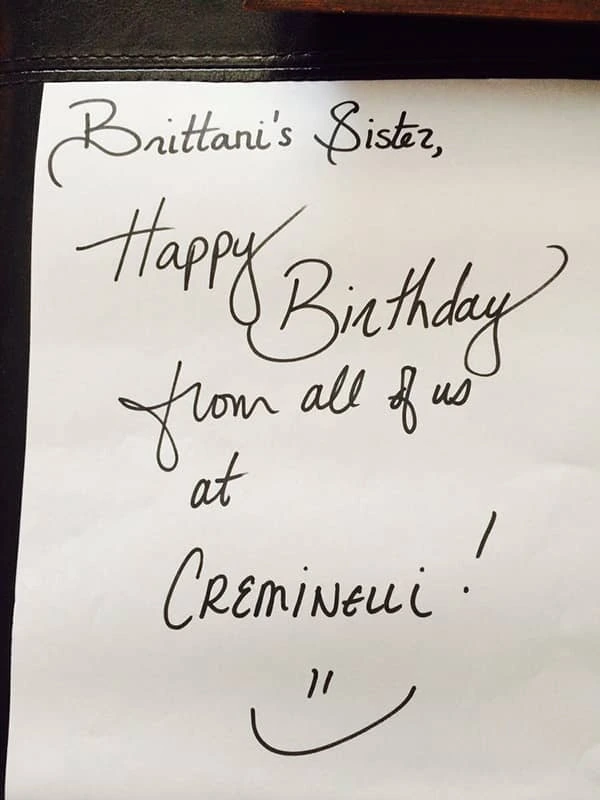
Make your customers happy with personal touches like this birthday note from Creminelli’s team.
Hiring additional staff can create a smoother shopping experience for your customers. What are other ways to delight them? Try using live chat to offer online shoppers the same great experience you’re creating in-store. Send thank-you cards to loyal customers before the big day. Hire a photographer, grab some seasonal props, and invite customers to snap their holiday photos while they shop.
There are tons of possibilities. Just think about what your customers will value most, then plan an initiative around it.
5. Don’t forget to follow through
You should have a simple way to gather contact info from customers on Small Business Saturday. This will build your mailing list so you can stay in touch year-round.
In all the hustle and bustle, make sure you engage on social media. Use the official Small Business Saturday hashtag #ShopSmall as you promote your business and chat with followers. Engaging on social media the day of an event is important, but more frequent posting is linked to higher engagement and loyalty from customers. We recommend amping up your posts both before and after Small Business Saturday.
And finally, it doesn’t hurt to offer discounts once the new year rolls around. This will help you stand out in customers’ minds from every other retailer.
Try Lucidpress today to create beautiful promotional materials for your brand—no expert knowledge required.
You’ve got a great idea for a flyer: a new business service, a store’s grand opening, an upcoming concert, open house or event. And you’ve got Lucidpress to make designing your flyer a snap. Now all you need… is an audience. Welcome to Flyering 101, where you’ll learn how to nail (no pun intended) your flyer distribution.
Related: 17 flyer layout design ideas for your inspiration
According to our research, here are the top six issues to consider before distributing your flyers.
1. Consider your message.
Certain messages are better suited for flyers than others. Most of them can be grouped under the same umbrella—that is, most flyers are announcements. Maybe you’re trying to drum up interest for a new business or invite people to a local festival.
There are lots of occasions which call for an easy, low-cost form of direct marketing. Is your flyer ready for primetime? Make sure you’re completely satisfied with every aspect of your flyer, from content to design. Because once you print out hundreds or thousands of copies, there’s no going back.
2. Consider your timing.
Allow me to state the obvious for a moment: flyers are made of paper. They’re not incredibly durable, and they don’t tend to last very long. If you’re hanging flyers outside, their lifespan could be substantially shortened by the elements. Before you get out the staple gun, check your local weather forecast for rain, snow, and heavy winds. If harsh weather is on the horizon, you might have to adjust your plans.
While we’re on the subject, take holidays into account as well. Around certain ones, like Halloween and Christmas, your flyer will be competing with a lot of decorations. Space might not be as readily available as it was before. That doesn’t mean you shouldn’t advertise around a holiday—especially if your message is seasonal or topical—but you should still take note.
3. Consider your audience.
Who should read your flyer? Is it of general interest, or does it address a specialized audience? It’s important to consider this before you start flyering. It’s one thing to hand them out to people. It’s another thing to hand them to the right people.
Distributing flyers to random strangers who pass you on the street might not be as effective as targeting a specific audience. In fact, in many cases, you might as well be putting your flyers in the trash. But once you understand who your audience really should be, you can put together a smarter distribution plan.
4. Consider your distribution method.
How are your flyers getting to your intended audience? You have a few choices. The most popular methods are:
- Hanging the flyers in public/community areas.
- Handing the flyers to people directly.
- Keeping a stack of flyers in a high-traffic area.
- Delivering the flyers door-to-door (or car-to-car).
The method you choose will have critical ramifications on your distribution plan. For example, how many flyers will you need to accomplish your goal? How long will it take to get rid of them all?
No matter where you’re flyering, make sure you get the right permissions. Not all places that are open to the public are open to flyering as well. Parks have maintenance staff. Neighborhoods have soliciting policies. Storefronts and cafés have managers. Schools have approval forms.
Don’t give up hope, though. Many times, you can chat with property owners to determine whether they’re open to flyering. If you see shops with flyers already out front, that’s a good sign. Many places, like college campuses and laundromats, have corkboards especially for flyers and local ads. Take a look around, and don’t be afraid to ask!
5. Consider your distribution team.
If you’re hanging or handing out flyers all by your lonesome, it’s going to be a long ride. Flyering moves much faster in a team. Fortunately, you can call on your support network for help. If you’re announcing a new store, employees can help. If it’s a party or a concert, you can recruit family and friends. If it’s a club or organization, it shouldn’t be hard to find volunteers.
The lower the quantity, the easier it will be to get all those flyers out into the world. However, if your back’s against the wall, you still have options. If you don’t have the time—and no one else seems to, either—give a flyering agency a call.
There are specialized businesses out there who take care of the entire distribution process, from start to finish. They can help you create a smart plan that targets your audience in a timely fashion. Some even offer GPS tracking so you can watch in real-time. Just keep in mind that you can’t control how the staff does its job, so choose your agency partner carefully.
6. Target your distribution.
Finally, take a good hard look at your distribution plan and make sure you’ve accounted for all the steps up to this point. Now that you have all the basics in line, you can make some advanced adjustments. Targeting your distribution is the final consideration that will have a major effect on your success, and there are two ways to do it.
- Geographic targeting. If you run a local business, you can target specific areas who are more likely to benefit from your services. You can choose the zip codes, cities, streets, or even neighborhoods to flyer. Take into account the topography and landscape of these areas. Some terrain will be harder to cover than others, such as hills or neighborhoods where houses are far apart.
- Demographic targeting. If you’re announcing a new location for your business, you might target loyal customers who you know will be interested. Or if your flyer addresses a specific need, like babysitting or landscaping, you might be selective about who gets a flyer. The idea is to give flyers only to the people who actually benefit from your message, so your flyer has a higher chance of success.
Flyering may be a cheap way to advertise, but that doesn’t mean you want to throw your money away. With these six considerations accounted for, you can craft a smart flyer distribution plan that helps you achieve your business or personal goals.
Whether you’re a recently funded startup or a business that has been operating for years, building brand awareness will always be a top priority.
According to one recent study, 89% of B2B manufacturing marketers said increasing brand awareness was a primary goal for their content marketing tactics—edging out both sales and lead generation.
In startup marketing, in particular, brand awareness is everything. Think about it from the perspective of your reputation: you’re the new kid on the block, entering a crowded marketplace and trying to serve an audience with increasingly fractured attention.
You’ve got to do anything you can to stand out, and marketing is the best way to do it. But in addition to carving out a space in your industry, building brand awareness also brings an additional benefit: anticipation.
People won’t just take your word for it and immediately buy your product or service. They need to be convinced. If you can make them legitimately excited for the idea—if you can start before your product is even released and get them to mark “launch day” on their calendars—you’ll come out all the better for it.
Your brand’s image is long-lasting
Simply put, your brand is your promise. There’s a reason why studies estimate that 45% of a brand’s image can be attributed to not just what it says, but how it chooses to say it.
For a startup, creating an awareness campaign that both a) lets people know you’re coming and b) tells them what you plan to do when you get there checks the boxes of “brand awareness” and “anticipation” at the exact same time.
Remember that your brand is going to outlive whatever your initial offering is. You’re not just trying to sell today’s idea; you’re trying to sell tomorrow’s, too. You need people to stay with you long after they’ve made their first sale, which is why the “brand awareness” side of the coin is so important.
Anticipation builds momentum
To say you’ll be strapped for cash as a startup is quite an understatement. You’re living in a world where every cent counts.
Even so, people are going to need time to discover your product or service. If you wait until launch day to begin this process, you might get where you need to be eventually—but it’s going to take a lot longer. Momentum doesn’t just happen; it needs to build. If you time things right, you can make sure you hit your crescendo on launch day (or as close to it as possible).
Focus on creating visual marketing collateral that doesn’t just “engage” people but actually gets them excited. Build presentations and other visual collateral that contrasts their life before your brand and after it. How will the “after” be better? How will the “after” be easier? These are the questions you need to answer to build excitement.
Think about what you’re trying to do as a Venn diagram. The circle on the left is your product or service. The circle on the right is the daily life of your ideal customer. That space in the middle where the two overlap? That’s the sweet spot you’re trying to fill. If you can find innovative ways to communicate that in the run-up, you’ll make people aware of your brand and get them excited for your launch at the same time.
Guide the court of public opinion
Give your new followers a place where they can discuss what you and they have to say. Whether they’re responding to your launch campaign in a positive or negative way, you need to know what the general response is. Plus, there’s never a better chance to do some course correcting than when you hear feedback straight from the horse’s mouth.
In terms of brand awareness and anticipation, this also creates something of an echo chamber effect. After a certain point, excited customers become brand ambassadors and start spreading your message alongside you. This takes some pressure off your organization while customers do some heavy lifting for you.
Prime your audience
At its core, building brand anticipation is about priming your audience before you launch your business. It’s a strategy with two goals: let people know you exist and tell them how you’re going to change their lives.
Rather than wait until your product/service is absolutely perfect before doing any marketing, you should start thinking (and acting) on this as soon as you can. It’s far better to have a preemptive awareness campaign, even a small one, than to keep everyone in the dark until you’re “ready.”
Why? Because the dirty little secret of entrepreneurship is that you’ll never be ready. Your product or service will never be perfect. To think otherwise is a fool’s errand. Fortune favors those who boldly strike out where others are too scared to try. []
Instead, start building brand awareness as soon as you can. Today. Right now. Don’t just sell the product—sell the benefits your brand will bring. Then by the time your product is ready, your customers will be, too.
A well-constructed digital marketing campaign can offer limitless possibilities for businesses who are open to implementing new, proactive strategies to go along with their most-revered traditional ones. After all, mixing up some old and new campaigns can bring interesting and promising results to data-driven businesses.
Among the most cost-effective ways to build and maintain a connection with your audience is through an email newsletter program. Yes, those recurring emails you’re used to receiving from your favorite brands and personalities can also be a catalyst for your own brand’s long-term success.
Related: How to make a newsletter in 9 steps
It’s easy to set up, too. For example, newsletter software like ActiveTrail’s email marketing automation platform (which offers newsletter templates and a responsive email editor) can be a great complement to the visuals you design in Lucidpress. But in any case, if you’re not yet implementing this strategy, here are 4 reasons to set up your own newsletter program soon.
Stabilize the flow of information
Your website and blog might offer the best content on the internet, but the thing is, most online visitors will still rarely spend more than a few seconds on any webpage. That’s why a proactive support system should be in place to keep people coming back. Remember, a blog often requires people to initiate contact, and as a business, this behavior can translate to inconsistent returns. But if you have an ongoing newsletter campaign, you can conveniently reach out to your customers and drive further engagement. By giving your audience instant access to promotions, new products and other updates, people will have a much easier time understanding what your brand can do for them.
Increase brand awareness
A newsletter can carry a substantial amount of information, making it easier to create awareness around your products and services. By proactively sending out new messages, customers and prospects will come to feel your brand is familiar and will think of it more often. It’s an efficient and consistent way to remind people of your presence, and if your content is timely and compelling, it’ll drive your audience to act.
Connect with new prospects
It’s no secret that people love to window-shop online. Much of the time, people are passively looking for products and services that they want, but they simply don’t have the time, money or right reason to buy now. A newsletter that provides prospective clients with valuable information helps them make favorable decisions when the right time comes. Use your newsletter to prove your expertise and stay in touch with potential customers until they’re ready to strike a deal.
Keep existing customers in the funnel
You lose some and you gain some. But how about gaining more? Companies can never completely eliminate churn, but a thoughtful newsletter campaign can certainly reduce the risk of annoying your recipients. By keeping them in the loop, getting their feedback, and introducing them to your latest offerings, customers will feel like you have something more to offer and that you’re consistently improving your services. The more you stay in touch with customers, the more likely they’ll feel valued and appreciated. []
Are you feeling inspired and optimistic about starting your own newsletter campaign? Don’t wait—roll out a program now and keep the deals coming in, not only from your existing customers, but from the thousands of prospective customers out there.
Here’s more than a dozen free newsletter templates to help you get started.
Engaging followers on social media to boost your brand’s popularity is a fine art. Undoubtedly, your audience is spending a sizable chunk of their time on social, but there are way too many things competing for their attention there.
Related: 10 best social media campaigns you haven’t tried yet
If you don’t want to simply get scrolled past in the news feed, you need a better social media strategy. And to build one, you need to experiment with different techniques. Today, we’re going to take notes from the pros. Here are 5 social media hacks to get the right people to notice your brand, engage with your content, and share your posts.
1. Starbucks—Involve your audience in your campaign
A picture is worth a thousand words, right? Well, what if you could share your product’s best pictures on Instagram… by getting your followers to do it for you? That’s exactly what Starbucks has done with a host of seasonal hashtags.

Source: Instagram
Starbucks constantly encourages followers to share their photos and, over time, has built a very active community of coffee lovers. They post their photos, and Starbucks shares the ones they like best.
As a result, the photo-taker gets attention and accolades, reinforcing the positive affinity they have for the brand. And Starbucks gets to spread beautiful pictures of their product that drive more engagement with their content.
You too can explore this option, starting by building a small community of users who love your product. Invite them to share pictures of themselves using your product, and watch how a win-win game can score points both for you and for your audience.
2. Just Eat—Hashtag your giveaways
Giving away freebies isn’t exactly a groundbreaker in business strategy, but there’s a better way to gain maximum impact. The food delivery app Just Eat nails this practice. It’s constantly running themed contests and food giveaways that ask users to tag their friends, send in entries, and generally join in the fun. As a result, for every item given away, Just Eat earns a great deal of traction and puts people in just the right mood for ordering food. #FindYourFlavor, #JustEatUK and #StrangerThings2 are just a few examples.
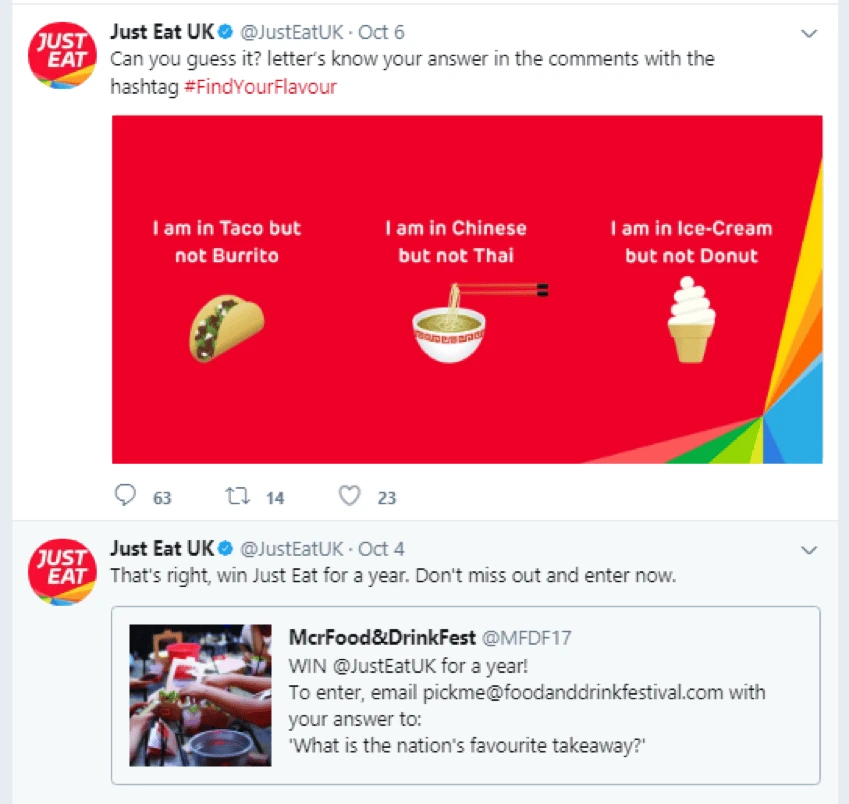
Source: Twitter
3. Lyft—Start a conversation
“While rival Uber is an efficient delivery service, Lyft is seeking to differentiate itself by offering a combination of ‘humanity and technology.”
Kira Wampler, Lyft CMO
Lyft crafts its social media strategy in that same vein by posting customer reviews, messages and conversations on their Twitter page. It aims to establish an identity as a warm, friendly taxi experience that nurtures relationships and cares about every single passenger. In fact, fantastic customer service has been Lyft’s calling card from the start, so playing it up on social media is a smart, brand-consistent move.
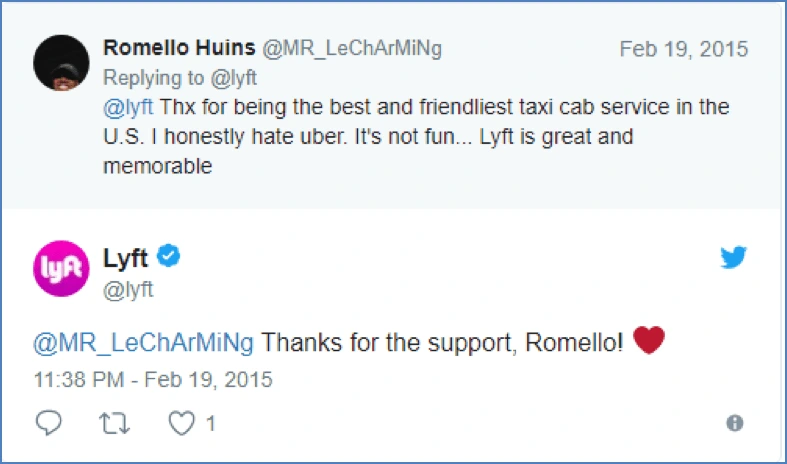
Source: Twitter
We all want to do business with brands that make us feel special. [] Forming personal relationships through conversation is basic human nature. You too can try exhibiting your warm, personal side by sharing users’ comments and conversations on your profile.
4. Pokémon Go—Roll out teasers before major updates
Pokémon Go brought augmented reality gaming to the masses and attracted a huge fanbase in very little time. However, with shrinking attention spans, the initial excitement could’ve fizzled out quickly if they didn’t find ways to keep the buzz going.
Fans of Pokémon Go are treated to small doses of upcoming excitement through a regular cadence of trailers and teasers. The anticipation for new levels, more items, and higher scores is enough to make fans look forward to playing every update, making it one of the highest grossing games ever.
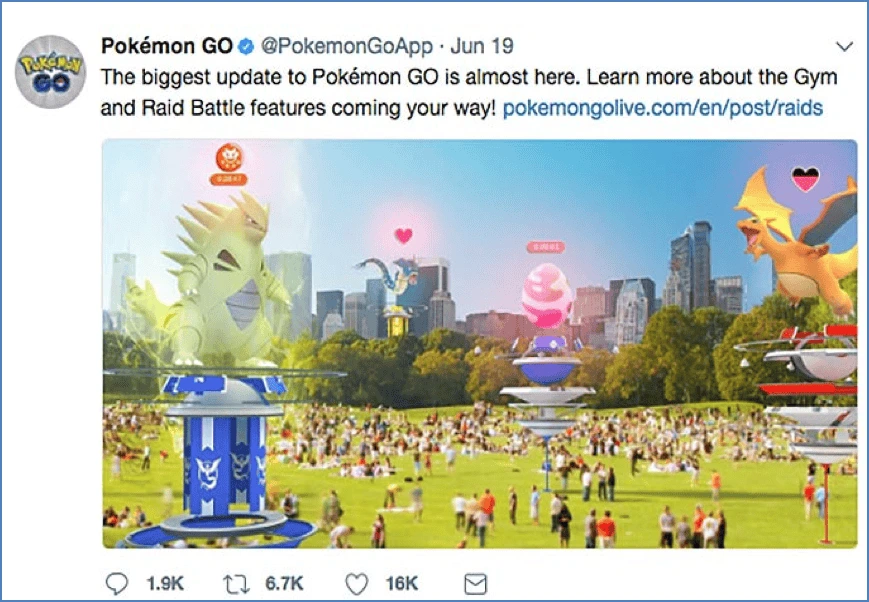
Source: Facebook
If you have a major update coming out, tease your followers with alluring clues, images and videos. This will keep the excitement alive until the update is finally out.
5. Angry Birds—Have a little fun with games
Angry Birds has been on social media since 2009, and from the start, their team has infused their brand’s personality with the fun of gaming. They are constantly running fun contests, posting fan artwork, giving away extra lives, and adding a light touch of humor to everything they post.
Plus, it’s not just your typical “share to win” giveaways. Contests come with clues and incentives to lure people into downloading the app. Riddles, puzzles, cryptic images and poems, it’s all there to keep users tuned in. Sometimes all it takes is a little fun and games to keep your audience engaged.
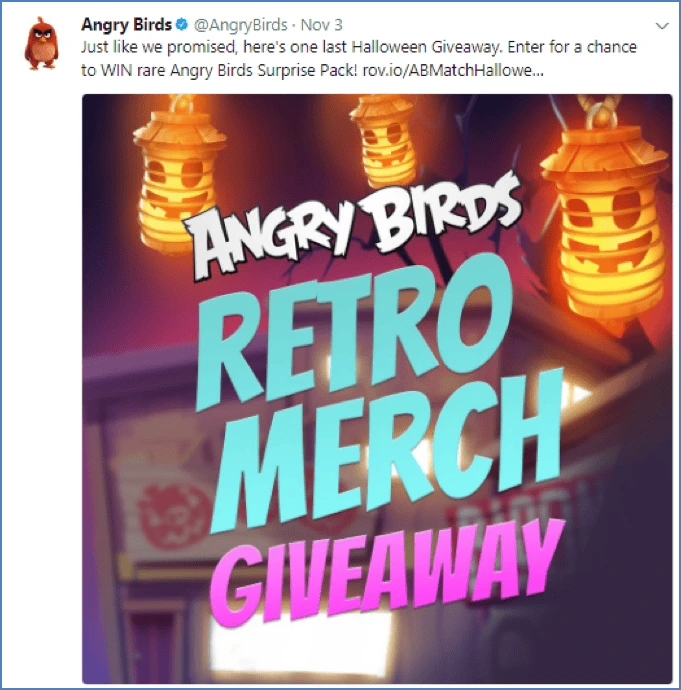
Source: Twitter
Wrapping up
Now you have 5 tried-and-tested strategies straight from the pros. These techniques can be adjusted and applied to nearly any brand willing to experiment with creative flair. The idea is to build connections and foster relationships with your users so you become part of their social lives. Try one (or more!) of the above tips and see how your audience responds—you might be surprised at your success.
Ready to drive more engagement and leads with social media? Grab a copy of our free eBook: How to adapt your brand to social media
When you run your own business, you’re responsible for a lot. Aside from keeping the business running smoothly, you’re responsible for producing your product or service, hiring employees, marketing and managing your brand, and doing anything else your business requires.
Related: Direct mail marketing: Does it still work?
Today, let’s focus on the marketing aspect of your business.
In this article, we’ll focus on one type of direct marketing known as direct mail. Specifically, we’ll offer 10 suggestions for how to implement direct mail in innovative and creative ways. To start, let’s take a look at exactly what direct marketing and direct mail is.
What are direct marketing and direct mail?
Direct marketing is an assertive form of promotion in which a company reaches out directly to its target market. The point of these campaigns is to connect with consumers on an individual level, showing that they’re important to the company.
One example of this is telemarketer calls. Some other types of direct marketing:
- Email marketing
- Direct mail marketing
- Direct-response advertising
- Face-to-face selling
- Text marketing
- Distributed leaflets & flyers
Our focus today is direct mail—where advertising content is sent directly to a target market’s mailbox. The content could include letters, postcards, flyers, or anything mailed directly to a home or place of business.
Is direct mail still effective?
When you use direct mail correctly, it can be an extremely helpful tool in your advertising toolbox. You can “speak” directly to your audience and give them detailed information about your brand. In addition, you can easily track the success of a campaign.
However, you must practice care when you’re conducting these campaigns.
If you do this incorrectly, consumers will view the content as “junk mail.” Avoid this by providing consumers with content that is timely, relevant and important to them. You can also provide useful tools—for example, a coupon or promo code for your services.
How to use direct mail creatively
Now that we know what direct mail is and the benefits it can bring you, let’s brainstorm a few ways to use it for your brand. Below, we’ve gathered 10 innovative ways that you can use direct mail for your business.
1. Deliver discounts
One common-sense choice for direct mail marketing is to send out info about discounts and specials. This could mean one of two things. First, you could send out direct mail when you have a sale coming up.
Second, you could send out coupons for your service that are exclusive to your direct mail campaign. This is a good way to measure response and ROI, because you’ll know whenever a customer redeems the discount.
2. Send out samples
In addition to sending out discounts, you can send out samples to your customers. Of course, you should only do this if you have ample budget for the expense. It’s probably not the best tactic to use for your first campaign, but after you’ve gotten a handle on typical response rates.
If you can swing it, samples are a great way to attract new customers who don’t want to pay money to try out your product. In addition, if you have new products, samples are a great way to introduce current customers to your new products.
3. Offer reminders
Reminders are a cheap way to stay top-of-mind. You can send out reminders for upcoming events—for example, a realtor could announce an open house. You could also call attention to grand openings, deadlines or appointments. An example you’re probably already familiar with is receiving a letter from your doctor or dentist about your yearly check-up.
4. Share announcements
You can also use direct mail to deliver company announcements. This keeps your customers up-to-date on new developments such as different hours, new contact info, new products and more.
5. Use QR codes
QR (quick response) codes are a great way to connect your mail campaigns to your digital marketing efforts. They’re simple barcodes that are easy to print on a piece of mail and can be scanned by any smartphone.
One scan, and a QR code can be customized to take your customer anywhere you need. For example, you could design a QR code to take your customers to a specific landing page. Most people are familiar with QR codes these days, so their presence on your mail will be self-explanatory and easy to follow.
6. Add texture
When someone goes through their mail, the last thing you want is for yours to be immediately disregarded or tossed away as junk. One way to combat this is to make your mail more eye-catching than the rest.
There are a few ways to do this, but one of the easiest is to add some texture to your mail. For example, you can use embossed lettering to make it stand out when a customer grabs a handful of letters and newspapers.
7. Pop with 3D mailers
Using texture is a subtle way of differentiating your mail, but there is a more obvious way to set your mail apart. You can send out 3D mailers, such as a box or tube or any other 3D design. These will jump out to customers and spike their curiosity, prompting them to open your mail and take a look rather than just throwing it away.
8. Track personalized URLs
One way to track how well your direct mail is working is to use personalized URLs (PURLs). Like QR codes, they’re a digital extension of your message. PURLs will lead your customers to your website in a way that leaves a trackable footprint. You’ll easily be able to see how many of your customers responded to your direct mail campaign by checking the page’s stats.
9. Try augmented reality
When people think of augmented reality today, they think about games like Pokémon GO. However, augmented reality does have a place outside of entertainment. In fact, you can incorporate the idea of augmented reality into your direct mailing.
Usually, this is done through the use of an app. For example, in 2015, Toys R Us used augmented reality techniques to create a game out of a piece of their direct mail.
10. Wow with video in-print
Finally, there are video in-print techniques. This is a cool idea because it eliminates the middlemen (apps, websites, etc.) by including a video player directly in the mail. Right now, these are a bit pricey—but keep an eye on them for the future.
Key takeaway
When executed creatively, direct mail marketing can provide a huge boost to your promotions and brand awareness. Whether your goal is to be top-of-mind or to drive bottom-funnel sales, you can build a direct marketing campaign to match. By crafting professionally designed mailers, you’ll attract your target audience and reinforce loyalty among your customers.
Learn more about the new direct mail features in Lucidpress, and give it a test drive.
Are you emotionally connected to a particular brand? Maybe it’s the design of its packaging. Maybe it’s the colors they use or the shapes that remind you of something good. Maybe it’s the smell of the store. When you go into a small fragrance boutique, you’re mesmerized by a unique scent that sticks in your memory. Whenever you decide to buy perfume in future, you’ll prefer going to that specific store.
Why does this happen? When you understand the psychological theory behind the human senses, you’ll realize why sensory marketing is so important. Our senses are our connection to the outside world. Our brain interprets the messages they send and forms its perception of the world in accordance with those interpretations.
Related: The subtle art of using emotion in your visual content
Marketers can implement sensory experiences to make their campaigns more effective. With sensory marketing techniques, you lay the foundation for a positive brand impression. Let’s see how our senses influence our perception of a brand, so we’ll understand this approach a bit better.
1. Taste
Unless you own a restaurant or coffee shop, this is the sense you can influence the least. However, taste can still become an important aspect of your marketing strategy. For example, if you’re promoting an Italian brand of jewelry, you could organize a cocktail for your most faithful customers where you serve Italian gelato and wine. These tastes will remind people of the Italian lifestyle, and they’ll see how your jewelry fits in.
The sense of taste can deeply influence our memories, emotions and moods. A savvy marketer will find ways to use that fact to the campaign’s advantage.
2. Sound
You already have experience with sound affecting your perception of a brand. When you dine in a fancy restaurant, you want slow, calm music in the background, right? When you’re at a nightclub, the music that’s being played affects your experience. When you enter a store, the music can make you feel energized or relaxed, depending on the selection.
But it’s not limited to in-store experiences. Daniel Monroe of BestEssays explains how sounds are important even for online services: “The element of sound was crucial when we were designing the live chat. We didn’t want our website visitors to be disturbed, which is why the live chat is never activated without their request. When they drop us a message, however, they surely want to be notified when the agent sends a response, so the sound has to be noticeable yet subtle. It has to create a sense of urgency without making the website user nervous.”
Think: what behavior are you trying to encourage in your target audience? What kind of music would promote such behavior? Once you answer this question, it becomes easier to implement music and sound effectively in your brand experiences.
3. Touch
The sense of touch also influences our behavior. Research has shown that touching rough or smooth objects has an effect on our decisions. Hard surfaces, for example, evoke the impression of firmness, stability and security. However, they also impose a sense of strictness. They might be great for offices or banks, but you’d want to include a bit of softness in a store that sells products for kids, right?
Many brands neglect the sense of touch in their campaigns, mainly because they’re selling products that already have a particular structure. The way you design the packaging and space around the products, however, will have a huge effect on the brand experience.
4. Sight
This is probably the sense that affects our brand perception the most, since we first see a product before involving any other senses in the experience. That’s why brands invest so much effort and resource in visual content.
When you’re presenting your brand to the world, advertising and packaging have a huge impact on audience perception. This effect is heightened when all your branding is consistent and cohesive. Posters, social media posts, flyers, newsletters and other promotional materials should all share a similar design and color scheme. After all, those colors are rarely chosen by accident.
For example, when we’re trying to evoke optimism, warmth and clarity, we often reach for the color yellow. Orange is cheerful and fun (like Fanta), and red is bold and exciting (like Virgin). Blue evokes trust, strength and dependability—think Dell and HP. Green is peaceful and symbolizes growth and health, which is why you’ll find it in the logos and marketing of many environmentally friendly or healthy lifestyle brands.
5. Smell
Have you ever wondered why brands like L’Occitane and Lush sell their products in specialized boutiques? It’s because their marketing campaigns are based on the sense of smell, and they don’t want their scents being diluted by other products in the store. When you get to the Lush store, you’re so mesmerized by the smells that you simply cannot leave without a new bar of soap. That’s how powerful scents can be.
Even if your brand is not related to scents, you can still benefit from sensory marketing. Researchers found that the smell of chocolate can boost sales in bookstores. They observed the behavior of the customers and concluded that when the bookstore smelled like chocolate, people were more engaged with the staff and the books. They looked more closely at books, read the summaries, and lingered in the store. That’s not a coincidence.
The smell of chocolate is comforting and inviting. It’s no wonder why many real estate agents like to bake something in the kitchen before showing the property to a potential customer. They also make sure the property is clean and smells nice in every room.
Just as a pleasant scent promotes better behavior, an unpleasant odor will have a negative effect. If the store is dusty or smells funky, it won’t matter how awesome your brand and products are. The smell will distract visitors from taking the action you want to encourage.
Key takeaway
Our senses have a major impact on our purchasing decisions. Sensory branding is a well-established practice in some industries, such as cosmetics and food. However, brands from all other industries can benefit from this approach, too. Which sensory marketing techniques could you take advantage of in your next branding campaign?
Last week I received a letter in my mailbox for the first time in a long time. It’s been ages since someone (even a company) sent me physical mail rather than going the easier route with email.
It really felt good to have something that I can touch and feel with my own hands.
Related: 11 best direct mail pieces to inspire your next campaign
Sometimes, the dull and boring side of advanced technology makes us realize we’ve come a long way. There was a time when people used to get a lot of mail in their mailboxes, especially in the form of promotional material.
Gradually, companies left that behind and considered it defunct. But in reality, direct mail is still a great way to engage with one’s audience.
Why? Because in our modern age, it provides a personal touch that email can never replicate. Data published by the Data & Marketing Association in 2016 showed that the response rate of direct mail increased 43% year-over-year. This is a huge leap from previous years.
Companies should know that it’s short-sighted to completely do away with direct mail. It’s still an effective and useful tool. To drive home the point, here are eleven reasons why every brand should (re-)consider direct mail.
1. You can achieve a higher ROI
Most companies set up online ads hoping to see better ROI because of the huge number of internet users.
But, direct mail can drive even better impact: a median ROI of 29% compared to online display at 16%.
When someone receives physical mail, it carries more weight (and not just literally). Customers are more likely to respond to communication that feels personal, and direct mail makes it easier to send that message.
2. Direct mail pairs well with digital marketing
If you want to build your own brand online or enhance the reputation of your company, digital marketing is usually the best place to start.
For many brands, this includes publishing SEO-optimized content and setting up Facebook ads. It usually doesn’t include direct mail… but maybe it should.
Direct mail can help you bridge the gap between the digital world and the real one. You can reach potential customers who might otherwise never hear about you—and you don’t always have to sacrifice data to do it.
For example, a digital marketing agency in our own state (Utah) included a scannable code on the back of one direct mail piece. They could track engagement with that code just like they would any other online campaign. They also included a Twitter hashtag that people could use to interact with the campaign. These techniques help to tie everything together, so their team got a holistic look at their campaign’s performance.
3. You can hold direct mail
This might seem obvious, but humans are sensory creatures. An email lives on your digital gadgets, where you’ll never be able to touch it. People can actually touch and feel the direct mail that a company sends to them, and because of that, it leaves a stronger impact.
This is especially valid for pieces that provide real-world value, like a free sample or discount coupon. Customers are more likely to remember and redeem those promotions than the ones they’re inundated with via email.
4. Attention, please!
When people check their mail, they take and go through everything they’ve received. It’s almost guaranteed that they will look at each and every piece, even if it’s only for a moment. Then they have to decide what to do with each piece—deciding which ones are worth saving and which ones are okay to throw away.
Conversely, when someone’s checking their email, they’re often engaged in other behaviors and environments that divide their attention. For example, they could be multi-tasking at work or watching TV on the couch. Since direct mail deals with fewer distractions, it benefits from better attention spans.
5. You can track direct mail
There are plenty of email & direct marketing tools to track the progress of your email campaigns. What about direct mail? Yes, it’s true that the process isn’t fully automated in the same way—but you can make them easier to track.
For example, you can designate a phone number or email address solely for the target audience of your direct mail campaigns. You can also create specialized landing pages with unique URLs. This will greatly improve the quality of your data and the accuracy of your success metrics.
6. All ages welcome
Any time you opt for a particular marketing strategy, it’s vital to understand which age groups that strategy serves.
In the case of email marketing campaigns or online advertisements, seniors are often left out because they adopt technology later than the younger generations. If seniors are a key demographic for you, you’re probably leaving money on the table.
Instead, consider reaching that audience with direct mail. And don’t assume seniors are the only ones—other audiences could benefit, too. Take a look at your audience and think about whether direct mail could extend your reach.
7. When others zig, you zag
Since digital marketing has so thoroughly transformed the landscape, many companies have quit using direct mail altogether. Just because fewer people are using it, however, doesn’t mean it’s an obsolete tool.
In fact, there’s a little bit of irony at play here: Your brand can stand out by reincorporating direct mail as part of your campaign. The high ROI speaks for its validity, and you can get the best of both worlds by adding physical mail to your digital campaign.
8. Direct mail can help you target specific audiences
We’re used to seeing the targeting capabilities of various social media platforms. But, did you know that direct mail can also target specific audiences?
For example, the USPS website has a tool called Every Door Direct Mail, which lets you send mail to addresses within a selected geographic area. This is the same system Lucidpress uses to send direct mail postcards from our platform to the local areas you want to target.
It’s not only about location, though. Address databases often contain other details you can use to target an audience: age, income, marital status & more. With these, you have granular control over who to send your direct mail to.
9. You can raise brand awareness
Are you trying to raise awareness of your brand? If you’re willing to build a campaign around that goal, direct mail can be a very effective way to achieve it.
As always, brand consistency is key, so keep your direct mail pieces consistent with overall branding.
You can earn extra points by including a coupon or another special offer, increasing the likelihood that your recipient will keep it around. The more times they view your direct mail piece, the more familiar your brand will feel to them.
10. Direct mail tickles the senses
Quick: name the five senses. Now, name the senses you can activate with a digital marketing campaign. Suddenly, your options are a lot more limited.
Sensory experience is a huge part of getting a response from an audience. If you’re only marketing online, you’re limiting yourself to sight and sound.
With direct mail, you can activate more senses like smell, taste and touch. (For example, think about those perfume ads you used to find in magazines.)
The more senses you can trigger, the more likely your customer will be moved by your message.
11. You can let your creative juices flow
In digital marketing, where best practices and A/B testing determine all, have you noticed that most company websites look… pretty similar?
Refreshingly, direct mail is a channel that brands can experiment with to create something new and innovative.
In fact, the more your mail stands out, the better. Take a look at some of the fun, creative ideas in this Pinterest board of direct mail marketing ideas:
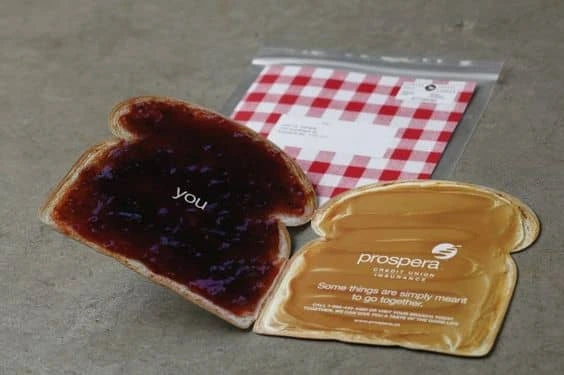
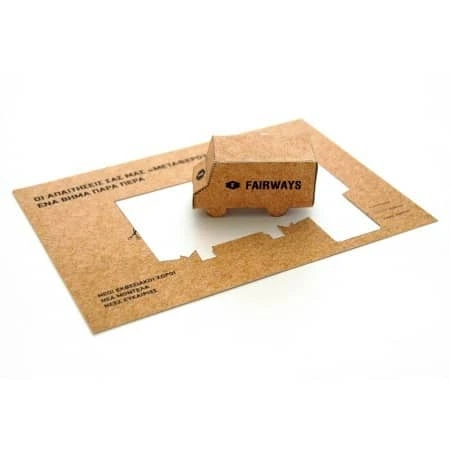
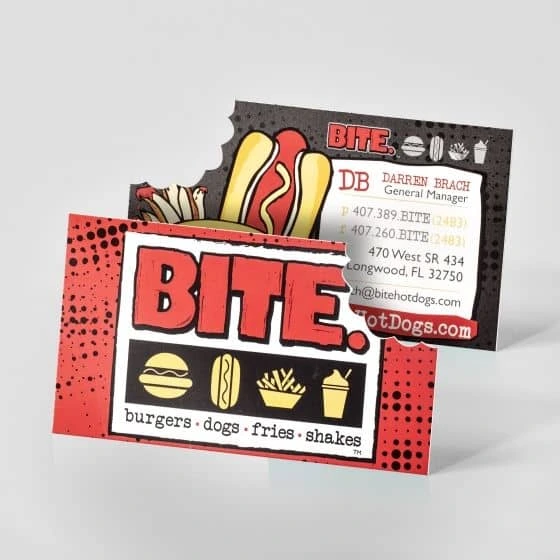
Key takeaway
Cutting direct mail from your marketing strategy because you assume it’s dead is misguided. Direct mail is still alive and well, and there are strong reasons to include it in a well-rounded campaign.
From higher ROI to stronger impact, brands are still reaping the benefits of direct mail today—and so can you. Bring these eleven reasons to your team the next time you’re planning a marketing campaign. They might just be surprised at the results.
Ready to build your own campaigns in minutes? Learn more about the direct mail features in Lucidpress, and give it a test drive.
If Instagram feels unavoidable these days, it’s because it is. The social media giant has over 1 billion monthly users and 90% of them follow at least one business. Needless to say, it’s smart to have an Instagram presence for your brand.
A business Instagram account can seem imperative, and they’re also a lot of work. To keep your followers engaged and maintain a consistent brand presence, you’ve got to post regularly — at least a few times a week. All that posting means you’re going to need a solid social media planner (maybe even a team!) to get your content ducks in a row.
Related: Free Instagram post templates
Coming up with content for Instagram can get old quick: You’ve got to strike the right balance of human-interest topics, brand promotion, aspirational content and customer engagement. Just posting high-quality images isn’t enough to drum up excitement for your brand. You also need to know how to drive engagement and which types of posts can boost sales. Here are 6 tried-and-true Instagram post ideas to help you get started.
What to post on Instagram
1. Endorsements
“Influencer” has quickly gone from being a kind-of-funny thing to becoming an actual profession. Influencing sells, period. People are genuinely interested in what other people are doing, and we love a recommendation.
And even if you’re not ready to hire a handful of socially adept personalities who shine in front of a camera, you can always lean on endorsements and product reviews from other people — whether that’s a well-known celebrity, industry expert or an average joe.
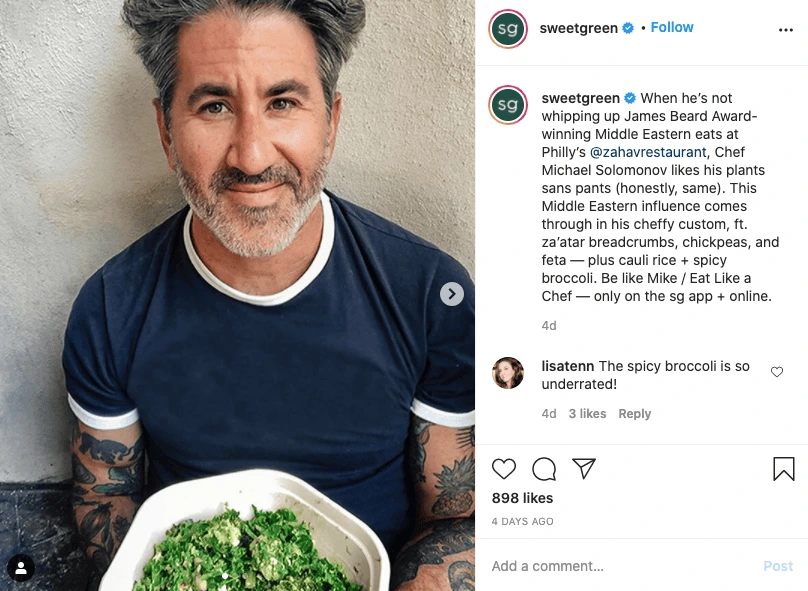
Source: Sweetgreen
Sweetgreen regularly posts content that features chef’s favorites from their restaurants. This does a few things:
- It offers social proof. It lets you know that experts in their field (chefs with highly refined taste buds!) frequent Sweetgreen, i.e. the food must be high quality and delicious.
- It satisfies curiosity. What are successful, talented people eating at Sweetgreen? Now you know.
- It’s far more interesting than a bland product-promotion post. Having someone else recommend your product and put their own spin on things helps spice up the content.
There are lots of different ways to feature endorsement-related content that will entice your followers. Brainstorm how you can use your current customer base to review, endorse or promote your products on Instagram.
2. Giveaways
Let’s be honest: Everyone loves free stuff.
It’s no secret that the word free is powerful, and many marketers use it in their copy to grab shoppers’ attention. That’s why samples and giveaways have become such a popular promotional tactic.
When you give away your product, you attract a larger audience of people willing to try your brand. It’s an opportunity to build brand awareness and encourage shoppers to try your product before buying it. Plus, it lowers the risk of trying something new.
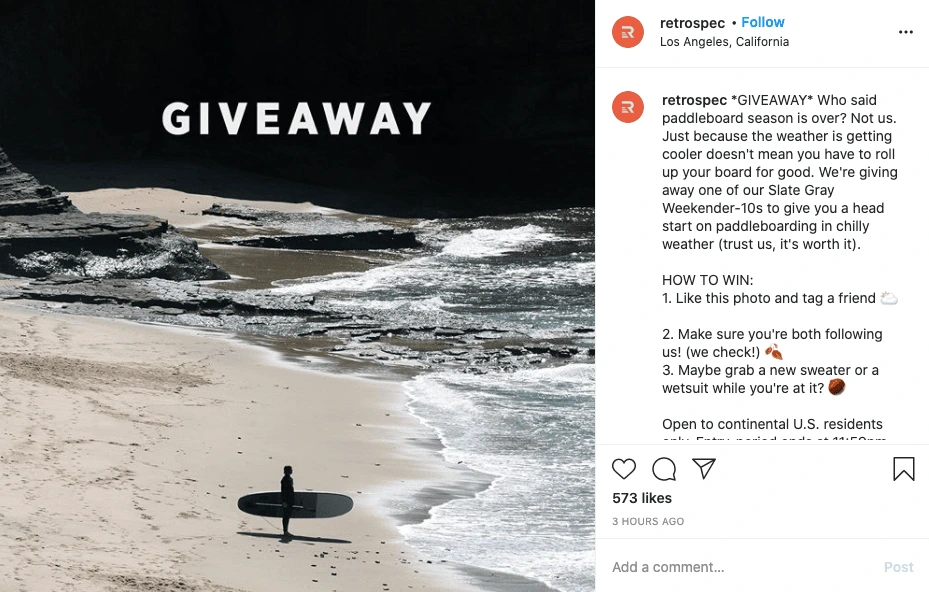
Source: Retrospec
Take Retrospec, for example, who gave away a much-sought-after paddleboard to keep their followers interested and engaged.
Since people love free stuff, this type of post often goes viral, attracting more followers who want a chance to win. If you want everyone to feel like a winner, you can even offer a discount to all entrants.
One point of caution: Not everyone who enters your giveaway will be interested in your brand. While the engagement may be impressive, you’ll likely notice a drop in followers once the promotion is over. That’s okay—those who leave probably aren’t a good fit for your target audience, and the ones who are will stick around.
3. Lifestyle photos
If you’re trying to sell a service rather than a product, give lifestyle content a try.
When you create an atmosphere that resonates with your followers’ lifestyle (or desired lifestyle), your brand feels more authentic. Don’t focus on your service; focus on your potential customer.
For instance, Sotheby’s International Realty uses lifestyle photography to hint at what clients can expect from their services. But it’s not about selling real estate, it’s about selling the lifestyle — sophisticated, comfortable and luxurious.

Source: Sotheby’s International Realty
Lifestyle photos can help people imagine how they might feel after engaging with your brand. If that lifestyle speaks to their desires and sensibilities, this Instagram post idea can easily contribute to future business.
4. Inspirational quotes
We all have moments when we need to motivate ourselves. When you’re looking for a quick pick-me-up, the right inspirational quote can really lift your mood.
Even though inspirational content doesn’t always contribute directly to sales, it helps to illustrate your brand’s values. Plus, it has more potential to go viral, as people like to share content that reflects their own values, too.
Below, SoulCycle offers a thought that would be sure to make you pause if you saw it while scrolling through your feed. Short, relevant quotes like this can inspire your community.
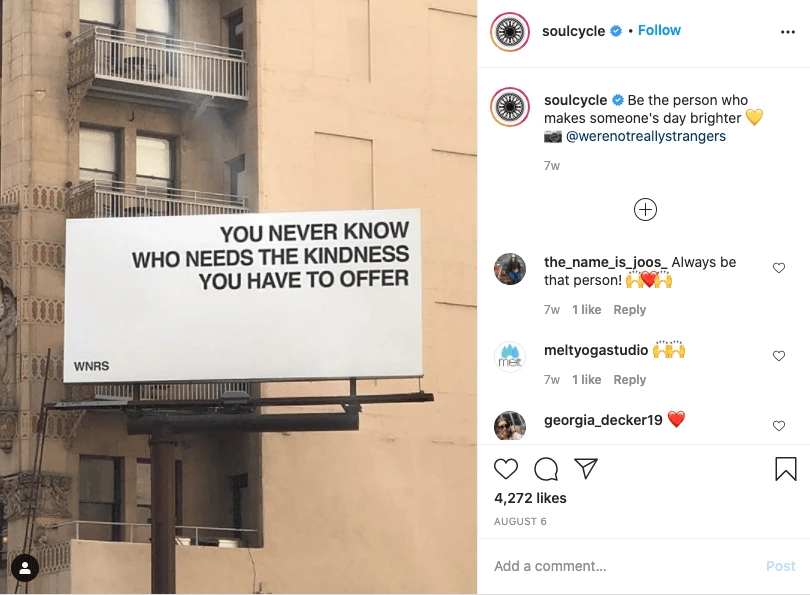
Source: SoulCycle
Sometimes less is more — and when it comes to Instagram, think first and foremost about fostering brand loyalty. If people draw inspiration from your brand, they won’t forget you.
5. Brand achievements
Your brand story matters to your customers, and so does your success.
When you share your brand’s achievements, you build trust and reinforce loyalty, which often leads to sales, support or donations. Reputation plays a big role when it comes to spending decisions, and your achievements prove that you’re a successful organization.
World Wildlife Fund often highlights its accomplishments on Instagram, showing its patrons and followers that their financial support is being put to good use. Content like this does double duty: It gives followers’ feeds a boost with good-news stories and it promotes the brand’s work.

Source: World Wildlife Fund
Achievement comes in many forms — brand development, product launches, customer growth, charitable initiatives — so keep your eyes open for opportunities to tell your story on Instagram. You might be surprised by how creatively you can visually represent your brand’s success.
Watch for ways to build trust and reinforce loyalty with your followers. Sharing your brand’s success will improve your reputation and impress potential customers.
6. Limited-time offers
As social creatures, it’s human nature to hate missing something important. Marketers should use FOMO (fear of missing out) to their advantage. One example is a limited-time sale, coupon or discount.
Take a look at Nékter. This franchise knows how to use sales to grab attention and encourage repeat purchases. How do they do it? Descriptive captions, a clear offer and bright, detailed photography all work together to deliver a compelling offer.
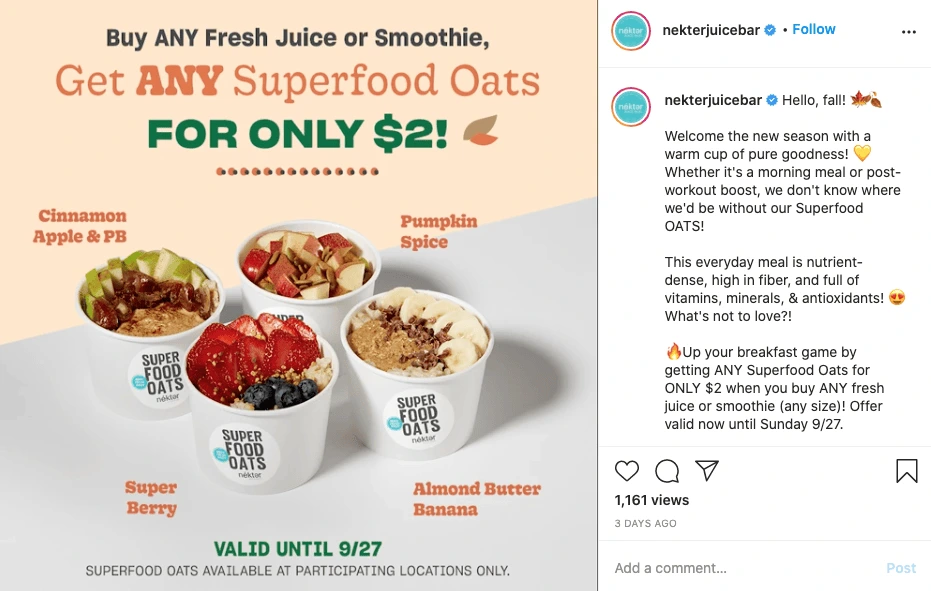
Source: Nékter Juice Bar
Nothing delays action more than uncertainty. Run your sales for a short period of time to give your followers a clear understanding of when and how they should act. If you run sales all the time, your audience will adjust and expect discounts continuously. Instead, make them feel like they’re getting a real deal by purchasing now.
Use compelling visuals to announce your offer, then provide followers with a clear deadline to increase urgency.
Key takeaway
Over the past few years, Instagram has evolved into a powerful marketing platform that gives brands new opportunities to boost sales. Investing in the right kinds of Instagram post ideas is a strategic way to influence the buying process.